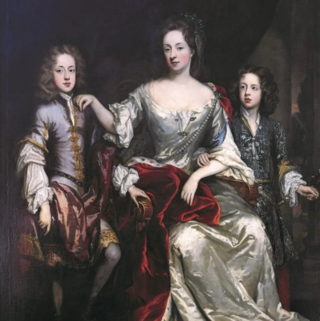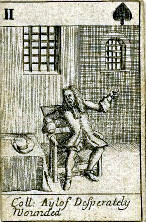Personal details
Henry Danvers was born 8 July 1622 in Swithland, Leicestershire, second son of William Danvers (1591–1656), a minor member of the Landed gentry, and his wife Elizabeth Babington (died 1678). In March 1644, he married a distant relative, Ann Coke, daughter of Sir John Coke, Secretary of State to Charles I from 1625 to 1640. They had seven children, of whom only three survived to adulthood; Samuel (1652–1693), Mercy (1654–1702) and William (1666–1740).
Career
Danvers is thought to have attended Trinity College, Cambridge and like his father supported Parliament when the First English Civil War began in August 1642. While the details of his military service are unclear, in 1647 he was appointed to the Committee for Staffordshire, one of the Parliamentary bodies set up to administer local government during the civil war. Following the 1647 Putney Debates, he was associated with Thomas Harrison and other radicals in drafting the constitutional manifesto known as An Agreement of the People. In 1650, he was appointed Colonel of the Staffordshire Militia and governor of Stafford, a position he retained until 1652. During the 1650 to 1651 Anglo-Scottish War, he was commended by the English Council of State for raising troops to oppose the Scottish invasion which ended at the Battle of Worcester in September 1651.
Originally a religious Independent, during his time in Stafford Danvers became a General Baptist, a sect whose members included many radicals within the New Model Army and the Levellers. In early 1653, he was nominated to Barebone's Parliament as MP for Leicestershire and moved to London where he joined the church of Edmund Chillenden. In 1657, when he held the rank of major, Danvers, with Harrison, Vice-admiral Lawson, Colonel Rich, and other Baptists, was placed under arrest on suspicion of being concerned in a conspiracy against Oliver Cromwell's life.
A few months after Cromwell's death in September 1658, Danvers was appointed Commissioner of the Staffordshire Militia in June 1659 but lost all his offices following the 1660 Stuart Restoration. In June 1661, he was rumoured to be planning a rebellion in conjunction with Clement Ireton and in early 1662 was accused of involvement in an alleged plan to assassinate Charles II known as the "Tong Plot". He managed to evade arrest although four other conspirators were executed.
Around 1663, reports had Danvers in disguise visiting the ejected minister Anthony Palmer, and linked to other radical plotters: the imprisoned John Breman, George Joyce in the Netherlands, and John Toomes. He returned to London in August 1665 and was arrested but rescued by a crowd whilst being taken to the Tower of London. [6] Danvers vested his estate with trustees, to shelter it; and was joint-elder of a Baptist congregation near Aldgate, London. In the late 1670s he supported Algernon Sidney in efforts to be elected a Member of Parliament. In December 1684 he published a seditious libel alleging the supposed suicide of Arthur Capell, 1st Earl of Essex was in fact state-sponsored murder and the government offered a reward for his apprehension.
When the Catholic James II succeeded his brother Charles in February 1685, Danvers attended private meetings where William Disney briefed him and John Wildman on the planning for Monmouth's Rebellion. Although cautious not to commit himself, he may have agreed to raise London in favour of the Duke of Monmouth. Also involved in the London plotting was Matthew Meade, who lingered in Essex. [9] Then Nathaniel Hooke was sent to London and Danvers, as Monmouth moved into Somerset. [10] At first he said he would not take up arms till the duke was proclaimed king; and when Monmouth had been proclaimed, that republicans were absolved from all engagements to a leader who had broken faith. On 27 July 1687 a royal proclamation was issued commanding Danvers and others to appear before his majesty or to surrender themselves in twenty days. Danvers succeeded in escaping to the Dutch Republic, and died at Utrecht at the end of 1687.

The Rye House Plot of 1683 was a plan to assassinate King Charles II of England and his brother James, Duke of York. The royal party went from Westminster to Newmarket to see horse races and were expected to make the return journey on 1 April 1683, but because there was a major fire in Newmarket on 22 March, the races were cancelled, and the King and the Duke returned to London early. As a result, the planned attack never took place.

Anne Scott, 1st Duchess of Buccleuch was a wealthy Scottish peeress. After her father died when she was a few months old, and her sisters by the time she was 10, she inherited the family's titles. She was married to James Scott, 1st Duke of Monmouth, and the couple had six children, only two of whom survived past infancy.

Edward Byllynge was a British colonial administrator and governor of West New Jersey from 1680 to 1687, until his death in England. Byllynge owned a large section of land in New Jersey with the Quakers.

Ford Grey, 1st Earl of Tankerville, PC was an English peer and politician.

Thomas Thynne was an English landowner of the family that is now headed by the Marquess of Bath and politician who sat in the House of Commons from 1670 to 1682. He went by the nickname "Tom of Ten Thousand" due to his great wealth. He was a friend of the Duke of Monmouth, a relationship referred to in John Dryden's satirical work Absalom and Achitophel where Thynne is described as "Issachar, his wealthy western friend".

The Lieutenant of the Tower of London serves directly under the Constable of the Tower. The office has been appointed at least since the 13th century. There were formerly many privileges, immunities and perquisites attached to the office. Like the Constable, the Lieutenant was usually appointed by letters patent, either for life or during the King's pleasure.
Captain Paul Hobson was an antinomian Particular Baptist who served in the parliamentary army during the English Civil War.

John Ayloffe was an English lawyer, political activist, and satirist, described as "one of the most consistently committed radicals of the century". According to his contemporary and political opponent Sir Roger L'Estrange, there were few 'more daring men for a desperate exploit'.

Essex Street Chapel, also known as Essex Church, is a Unitarian place of worship in London. It was the first church in England set up with this doctrine, and was established when Dissenters still faced legal threat. As the birthplace of British Unitarianism, Essex Street has particularly been associated with social reformers and theologians. The congregation moved west in the 19th century, allowing the building to be turned into the headquarters for the British and Foreign Unitarian Association and the Sunday School Association. These evolved into the General Assembly of Unitarian and Free Christian Churches, the umbrella organisation for British Unitarianism, which is still based on the same site, in an office building called Essex Hall. This article deals with the buildings, the history, and the current church, based in Kensington.
English county histories, in other words historical and topographical works concerned with individual ancient counties of England, were produced by antiquarians from the late 16th century onwards. The content was variable: most focused on recording the ownership of estates and the descent of lordships of manors, thus the genealogies of county families, heraldry and other antiquarian material. In the introduction to one typical early work of this style, The Antiquities of Warwickshire published in 1656, the author William Dugdale writes:
I offer unto you my noble countriemen, as the most proper persons to whom it can be presented wherein you will see very much of your worthy ancestors, to whose memory I have erected it as a monumentall pillar and to shew in what honour they lived in those flourishing ages past. In this kind, or not much different, have divers persons in forrein parts very learnedly written; some whereof I have noted in my preface: and I could wish that there were more that would adventure in the like manner for the rest of the counties of this nation, considering how acceptable those are, which others have already performed
Edward Norton was an English soldier and politician, an early Whig supporter and conspirator of the Rye House Plot.
Andrew Sall (1624–1682) was an Irish Jesuit, later a convert to the Church of England.
Robert Jenison (1584?–1652) was an English Puritan cleric and academic.
John Griffith (1622?–1700) was an English General Baptist minister.
William Sheppard was an English barrister, known as a legal writer.
This article is about the particular significance of the year 1724 to Wales and its people.

Peter Chamberlen M.D. (1601–1683), known as Peter the Third, was an English physician. The obstetrical forceps as invention has been credited to the Chamberlen family: the earliest evidence of what was a family trade secret points to his having it in 1630. He continued the family tradition of trying to bring the profession of midwifery under their control. His writings blend ideas associated with the Fifth Monarchists and Levellers with social schemes of his own with a utopian flavour.
Ann Smith was an English anti-Catholic political activist. A devout Baptist, she and her family sheltered the rebel 9th Earl of Argyll when he was in hiding in London and fled with him to the Spanish Netherlands in 1683. She lived with her husband in Utrecht and following his death funded Argyll's Rising in Scotland and the contemporaneous Monmouth Rebellion in England. She hosted fellow conspirator Elizabeth Gaunt in Amsterdam and received a royal pardon for her activism in 1686, after which time records of her life cease.
This page is based on this
Wikipedia article Text is available under the
CC BY-SA 4.0 license; additional terms may apply.
Images, videos and audio are available under their respective licenses.









